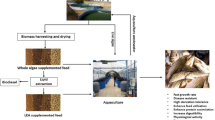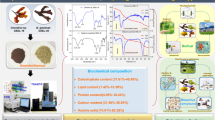Abstract
Through increased interest in the use of macroalgae for biofuel production, the concept of a biorefinery approach has been developed to improve its economic viability. This paper looks at the use of seaweed residue after enzymatic saccharification of the seaweeds Saccharina latissima, Alaria esculenta and Ulva lactuca as a novel feed component for the aquaculture industry. Chemical composition analysis was used to evaluate the impact of enzymatic treatment on the nutritional aspect of seaweed residue. During saccharification, the relative ash and carbohydrate content was reduced, but total nitrogen, total carbon and lipid content increased in all three species. In addition, the saccharification of S. latissima and A. esculenta resulted in the elimination of polyphenols, further enhancing the nutritional value of the residue. The residue supported the survival and growth of bivalve spat and commercially valuable sea urchins over the course of 3-week preliminary trials.






Similar content being viewed by others
References
Bird KT, Benson PH (1987) Seaweed cultivation for renewable resources. Elsevier Science, New York
Hughes AD, Kelly MS, Black KD, Stanley MS (2012) Biogas from macroalgae: is it time to revisit the idea. Biotechnol Biofuels 5(86):1–7
Kraan S (2013) Mass-cultivation of carbohydrate rich macroalgae, a possible solution for sustainable biofuel production. Mitig Adapt Strateg Glob Chang 18(1):27–46
Burton T, Lyons H, Lerat Y, Stanley M, Rasmussen MB (2009) A review of the potential of marine algae as a source of biofuel in Ireland. Sustainable Energy Ireland-SEI, Dublin
Ross A, Jones J, Kubacki M, Bridgeman T (2008) Classification of macroalgae as fuel and its thermochemical behaviour. Bioresour Technol 99(14):6494–6504
Dave A, Huang Y, Rezvani S, McIlveen-Wright D, Novaes M, Hewitt N (2013) Techno-economic assessment of biofuel development by anaerobic digestion of European marine cold-water seaweeds. Bioresour Technol 135:120–127
Hill J, Nelson E, Tilman D, Polasky S, Tiffany D (2006) Environmental, economic, and energetic costs and benefits of biodiesel and ethanol biofuels. Proc Natl Acad Sci U S A 103(30):11206–11210
FAO (2014) The state of world fisheries and aquaculture 2014: opportunities and challenges. Food and Agriculture Organization of the United Nations, Rome
Duerr EO, Molnar A, Sato V (1998) Cultured microalgae as aquaculture feeds. J Mar Biotechnol 6:65–70
Knauer J, Southgate PC (1999) A review of the nutritional requirements of bivalves and the development of alternative and artificial diets for bivalve aquaculture. Rev Fish Sci 7(3–4):241–280
Camacho P, Salinas J, Fuertes C, Delgado M (2004) Preparation of single cell detritus from Laminaria saccharina as a hatchery diet for bivalve mollusks. Mar Biotechnol 6(6):642–649
Duggins D, Simenstad C, Estes J (1989) Magnification of secondary production by kelp detritus in coastal marine ecosystems. Science 245(4914):170–173
Mann K (1988) Production and use of detritus in various freshwater, estuarine, and coastal marine ecosystems. Limnol Oceanogr 33(4 part 2):910–930
Sluiter A, Hames B, Ruiz R, Scarlata C, Sluiter J, Templeton D (2008) Determination of ash in biomass. National Renewable Energy Laboratory, Golden, NREL Report No. TP-510-42622
Dubois M, Gilles KA, Hamilton JK, Rebers P, Smith F (1956) Colorimetric method for determination of sugars and related substances. Anal Chem 28(3):350–356
Waterhouse AL (2002) Determination of total phenolics. In: Wrolstad RE, Acree TE, An H, Decker EA, Penner MH, Reid DS, Sporns P, Schwartz SJ, Shoemaker C (eds) Current protocols in food analytical chemistry. John Wiley & Sons, New York, pp I1.1.1–I1.1.8
Slocombe SP, Ross M, Thomas N, McNeill S, Stanley MS (2013) A rapid and general method for measurement of protein in micro-algal biomass. Bioresour Technol 129:51–57
Slocombe SP, Zhang Q, Black KD, Day JG, Stanley MS (2013) Comparison of screening methods for high-throughput determination of oil yields in micro-algal biofuel strains. J Appl Phycol 25(4):961–972
Larson TR, Graham IA (2001) Technical advance: a novel technique for the sensitive quantification of acyl CoA esters from plant tissues. Plant J 25(1):115–125
Roleda MY, Slocombe SP, Leakey RJ, Day JG, Bell EM, Stanley MS (2013) Effects of temperature and nutrient regimes on biomass and lipid production by six oleaginous microalgae in batch culture employing a two-phase cultivation strategy. Bioresour Technol 129:439–449
Carboni S, Hughes AD, Atack T, Tocher DR, Migaud H (2015) Influence of broodstock diet on somatic growth, fecundity, gonad carotenoids and larval survival of sea urchin. Aquacult Res 46(4):969–976
Suckling C, Symonds R, Kelly M, Young A (2011) The effect of artificial diets on gonad colour and biomass in the edible sea urchin Psammechinus miliaris. Aquaculture 318(3):335–342
Schiener P, Black KD, Stanley MS, Green DH (2015) The seasonal variation in the chemical composition of the kelp species Laminaria digitata, Laminaria hyperborea, Saccharina latissima and Alaria esculenta. J Appl Phycol 27(1):363–373
Whyte J, Englar J, Borgmann P (1981) Compositional changes on freshwater leaching of the marine algae Nereocystis luetkeana and Macrocystis integrifolia. Can J Fish Aquat Sci 38(2):193–198
Rosell K, Srivastava LM (1984) Binding of inorganic elements to kelp residues. Hydrobiologia 116(1):505–509
Trivedi N, Gupta V, Reddy C, Jha B (2013) Enzymatic hydrolysis and production of bioethanol from common macrophytic green alga Ulva fasciata Delile. Bioresour Technol 150:106–112
Siddhanta A, Prasad K, Meena R, Prasad G, Mehta GK, Chhatbar MU et al (2009) Profiling of cellulose content in Indian seaweed species. Bioresour Technol 100(24):6669–6673
Percival E (1979) The polysaccharides of green, red and brown seaweeds: their basic structure, biosynthesis and function. Br Phycol J 14(2):103–117
Arasaki S, Arasaki T (1983) Low calorie, high nutrition vegetables from the sea to help you look and feel better. Japan Publications, USA
Taher H, Al-Zuhair S, Al-Marzouqi AH, Haik Y, Farid M (2014) Effective extraction of microalgae lipids from wet biomass for biodiesel production. Biomass Bioenergy 66:159–167
You J, Peng C, Liu X, Ji X, Lu J, Tong Q et al (2011) Enzymatic hydrolysis and extraction of arachidonic acid rich lipids from Mortierella alpina. Bioresour Technol 102(10):6088–6094
Tanyaros S, Chuseingjaw S (2014) A partial substitution of microalgae with single cell detritus produced from seaweed (Porphyra haitanensis) for the nursery culture of tropical oyster (Crassostrea belcheri). Aquacult Res. doi:10.1111/are.12662
Uchida M, Nakata K, Maeda M (1997) Introduction of detrital food webs into an aquaculture system by supplying single cell algal detritus produced from Laminaria japonica as a hatchery diet for Anemia nauplii. Aquaculture 154(2):125–137
Felix N, Brindo RA (2014) Evaluation of raw and fermented seaweed, Ulva lactuca as feed ingredient in giant freshwater prawn Macrobrachium rosenbergii. Int J Fish Aquat Stud 1(3):199–204
Acknowledgments
This project was funded under the Genomia Fund award to ADH and from the European Union’s Seventh Framework Programme for research, technological development and demonstration under grant agreement no. 606042. Thanks also go to Mr. Lars Brunner for his help in the seaweed collection.
Author information
Authors and Affiliations
Corresponding author
Rights and permissions
About this article
Cite this article
Schiener, P., Atack, T., Wareing, R. et al. The by-products from marine biofuels as a feed source for the aquaculture industry: a novel example of the biorefinery approach. Biomass Conv. Bioref. 6, 281–287 (2016). https://doi.org/10.1007/s13399-015-0190-6
Received:
Revised:
Accepted:
Published:
Issue Date:
DOI: https://doi.org/10.1007/s13399-015-0190-6




